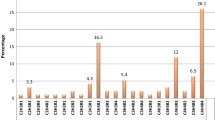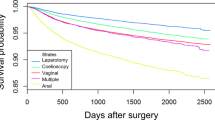Abstract
Purpose
Pelvic organ prolapse (POP) can cause incomplete bladder emptying or hydronephrosis and renal failure. These are serious conditions, especially in elderly women, requiring resolution of POP. Pessary use is an alternative, but there are specific problems or patients may not want it. We therefore conducted a retrospective study on surgical treatment of elderly women with respect to the type of surgery and intra- and postoperative complications.
Methods
From two urogynecologic centers, we reviewed treatment data between 2003 and 2013, including patients ≥80 years of age. From the hospital records, intra- and postoperative data were extracted.
Results
91 cases met the inclusion criteria. Mean age was 84.38 years (±3.05, max 92 years). Two patients (2.2%) were diagnosed with hydronephrosis and two with urosepsis/renal failure. The mean length of surgery was 81 min (±45 min, range 10–270), 94.5% of patients were under general anesthesia. Two bowel lesions occurred. The mean length of hospital stay was 8 days (range 1–22, n = 90). There were no perioperative mortalities. Six patients (6.6%) were admitted to intensive care unit.
Conclusions
In the future, we will be facing a growing number of elderly women seeking care for POP. In our retrospective analysis, we were able to show that POP surgery could be performed safely. We therefore consider surgical treatment as a valuable alternative if pessary use is not an option.
Similar content being viewed by others
Abbreviations
- POP:
-
Pelvic organ prolapse
- ASA:
-
American Society of Anesthesiologists
- UTI:
-
Urinary tract infection
- RVV:
-
Residual voiding volume
References
Mathers CD, Murray CJ, Lopez AD et al (2002) Global patterns of healthy life expectancy for older women. J Women Aging 14(1–2):99–117
Pizarro-Berdichevsky J, Clifton MM, Goldman HB (2015) Evaluation and management of pelvic organ prolapse in elderly women. Clin Geriatr Med 31(4):507–521. doi:10.1016/j.cger.2015.06.008 (epub 29 Jul 2015)
Culligan PJ (2012) Nonsurgical management of pelvic organ prolapse. Obstet Gynecol 119(4):852–860
Patel MS, Mellen C, O’Sullivan DM et al (2011) Pessary use and impact on quality of life and body image. Female Pelvic Med Reconstr Surg 17(6):298–301
Thiagamoorthy G, Cardozo L, Srikrishna S et al (2014) Management of prolapse in older women. Post Reprod Health 20(1):30–35 (epub ahead of print)
Menard JP, Mulfinger C, Estrade JP et al (2008) Pelvic organ prolapse surgery in women aged more than 70 years: a literature review (article in French). Gynecol Obstet Fertil 36(1):67–73. doi:10.1016/j.gyobfe.2007.04.025 (epub 10 Jan 2008)
https://www.asahq.org/resources/clinical-information/asa-physical-status-classification-system. Accessed 11 Jan 2017
Thys SD, Roovers JP, Geomini PM et al (2012) Do patients prefer a pessary or surgery as primary treatment for pelvic organ prolapse. Gynecol Obstet Invest 74(1):6–12 (epub 28 Jun 2012)
Roth TM (2007) Pyometra and recurrent prolapse after Le Fort colpocleisis. Int Urogynecol J Pelvic Floor Dysfunct 18(6):687–688 (epub 26 Sep 2006)
Kaplan HS (1990) Sex, intimacy, and the aging process. J Am Acad Psychoanal 18(2):185–205
Gultekin FA, Wong MT, Podevin J et al (2015) Safety of laparoscopic ventral rectopexy in the elderly: results from a nationwide database. Dis Colon Rectum 58(3):339–343. doi:10.1097/DCR.0000000000000308
Gabriel B, Rubod C, Córdova LG et al (2010) Prolapse surgery in women of 80 years and older using the Prolift™ technique. Int Urogynecol J 21(12):1463–1470. doi:10.1007/s00192-010-1217-y (epub 1 Sep 2010)
Schweitzer KJ, Vierhout ME, Milani AL (2005) Surgery for pelvic organ prolapse in women of 80 years of age and older. Acta Obstet Gynecol Scand 84(3):286–289
Author contributions
The authors’ contributions were as follows: JF: Protocol/project development, Data collection or management, Data analysis, Manuscript writing/editing, other (performed surgeries). DW: Manuscript writing/editing, other (performed surgeries). HZ: Protocol/project development, Data collection or management, Data analysis, Manuscript writing/editing. CW: Manuscript writing/editing. TF: Manuscript writing/editing, other (performed surgeries). BG: Protocol/project development, Manuscript writing/editing, other (performed surgeries).
Author information
Authors and Affiliations
Corresponding author
Ethics declarations
Funding
There was no funding.
Conflict of interest
The authors declare that they have no conflict of interest relevant for this study.
Ethical approval
This article does not contain any studies with human participants or animals performed by any of the authors.
Rights and permissions
About this article
Cite this article
Farthmann, J., Watermann, D., Zamperoni, H. et al. Pelvic organ prolapse surgery in elderly patients. Arch Gynecol Obstet 295, 1421–1425 (2017). https://doi.org/10.1007/s00404-017-4367-z
Received:
Accepted:
Published:
Issue Date:
DOI: https://doi.org/10.1007/s00404-017-4367-z




